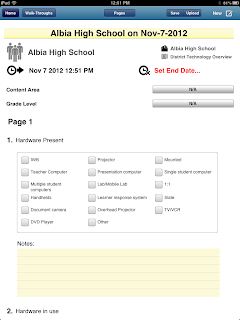We have two data-collection tools that we use in schools, and we use them for different puposes.
Intentional Follow-Ups
 |
| A screenshot of our Intentional Follow-Ups form |
- What are we following-up on? (Ex.: interactive whiteboard training, Google Apps training)
- Is the teacher implementing what they were trained on? (rated on a scale of 0 to 5)
- Are the components of successful tech integration present? (adequate hardware, content [TPACK], access, PD, and tech support)
- What challenges do the teachers face?
- What are our next steps?
We use this data to plan for future trainings and support.
Building Walk-Arounds
 |
| A screenshot of our Walk-Around eWalk template |
- What hardware is present? (we have an extensive checklist of possible hardware that could be in the room)
- What hardware is being used? (what is actually being used a the time we're looking in the room)
- What is the instructional setting? (teacher-led, student-led, project-based, whole group, small group, or individual/independent)
- What are the students doing? What digital content are they accessing, and what tools are they using?
- Are the students producing and creating, or are they passive and receiving? (Bloom's taxonomy)
These are pretty broad questions, but the data does give a good overview of how much technology is available for teachers, how it is being used, and at what level. Again, we use this data to plan for future trainings and support. And we share this data with districts so that they can plan for future purchases and trainings.